An Evaluation of the Ceiling Depth’s Impact on Skylight Energy Performance Predictions Through a Building Simulation
Abstract
1. Introduction
2. Research Methods
2.1. Study Model and Variables
2.2. Simulation Tools and Modeling Conditions
2.3. Sensitivity Analysis
3. Results and Discussion
3.1. Sensitivity Analysis
3.2. Energy Efficiency of Skylight
3.3. Ceiling Depth and Skylight Energy Efficiency
3.4. Skylight Optimization
4. Conclusions
Author Contributions
Funding
Conflicts of Interest
References
- Al-Ashwal, N.T.; Hassan, A.S. The impact of daylighting-artificial lighting integration on building occupant’s health and performance. ITJEMAST 2018, 9, 97–105. [Google Scholar]
- Gago, E.J.; Muneer, T.; Knez, M.; Köster, H. Natural light controls and guides in buildings. Energy saving for electrical lighting, reduction of cooling load. Renew. Sustain. Energ. Rev. 2015, 41, 1–13. [Google Scholar] [CrossRef]
- Danny, H.W.L.; Angela, C.K.C.; Stanely, K.H.C.; Eric, W.M.L. Study of daylight data and lighting energy savings for atrium corridors with lighting dimming controls. Energ. Build. 2014, 72, 457–464. [Google Scholar]
- Sikder, S.K.; Eanes, F.; Asmelash, H.B.; Kar, S.; Koetter, T. The Contribution of Energy-Optimized Urban Planning to Efficient Resource Use–A Case Study on Residential Settlement Development in Dhaka City, Bangladesh. Sustainability 2016, 8, 119. [Google Scholar] [CrossRef]
- Sikder, S.K.; Nagarajan, M.; Kar, S.; Koetter, T. A geospatial approach of downscaling urban energy consumption density in mega-city Dhaka, Bangladesh. Urban Clim. 2018, 26, 10–30. [Google Scholar] [CrossRef]
- Adahi, A.A.; Saghafi, M.R.; Tahbaz, M. The study of effective factors in daylight performance of light-wells with dynamic daylight metrics in residential buildings. Sol. Energy 2017, 155, 679–697. [Google Scholar] [CrossRef]
- Acosta, I.; Navarro, J.; Sendra, J.J. Towards an analysis of the performance of monitor skylights under overcast sky conditions. Energ. Build. 2015, 88, 248–261. [Google Scholar] [CrossRef]
- Acosta, I.; Navarro, J.; Sendra, J.J. Daylighting design with lightscoop skylights: Towards an optimization of shape under overcast sky conditions. Energ. Build. 2013, 60, 232–238. [Google Scholar] [CrossRef]
- Fang, Y.; Cho, S. Sensitivity analysis of skylight and clerestory design on energy and daylight performance of retail building. In Proceedings of the 2018 Building Performance Analysis Conference and SimBuild Co-Organized by ASHRAE and IBPSA-USA, Chicago, IL, USA, 26–28 September 2018. [Google Scholar]
- Motamedi, S.; Liedl, P. Integrative algorithm to optimize skylights considering fully impacts of daylight on energy. Energ. Build. 2017, 138, 655–665. [Google Scholar] [CrossRef]
- El-Abd, W.; Kamel, B.; Afify, M.; Dorra, M. Assessment of skylight design configurations on daylighting performance in shopping malls: A case study. Sol. Energy 2018, 170, 358–368. [Google Scholar] [CrossRef]
- Al-Obaidi, K.M.; Ismail, M.; Rahman, A.; Malek, A. Energy efficient skylight design in tropical houses. In Key Engineering Materials; Trans Tech Publications Ltd.: Stafa-Zurich, Switzerland, 2015; pp. 45–56. [Google Scholar]
- Laouadi, A.; Atif, M.R.; Galasiu, A. Towards developing skylight design tools for thermal and energy performance of atriums in cold climates. Build. Environ. 2002, 37, 1289–1316. [Google Scholar] [CrossRef]
- Coakley, D.; Raftery, P.; Keane, M. A review of methods to match building energy simulation models to measured data. Renew. Sustain. Energ. Rev. 2014, 37, 123–141. [Google Scholar] [CrossRef]
- Ghobad, L.; Place, W.; Cho, S. Design optimization of square skylights in office building. In Proceedings of the 13th Conference of the International Building Performance Simulation Association, Chambery, France, 26–28 August 2013. [Google Scholar]
- Kim, C.H.; Lee, S.E.; Kim, K.S. Analysis of energy saving potential in high-performance building technologies under Korean climatic conditions. Energies 2018, 11, 884. [Google Scholar] [CrossRef]
- Lee, K.; Baek, H.J.; Cho, C. The estimation of base temperature for heating and cooling degree-days for South Korea. J. Appl. Meteorol. Climatol. 2014, 53, 300–309. [Google Scholar] [CrossRef]
- DiLaura, D.L.; Houser, K.W.; Mistrick, R.G.; Steffy, G.R. The Lighting Handbook: Reference and Application; Illuminating Engineering Society of North America: New York, NY, USA, 2011; 1328p. [Google Scholar]
- Oh, M.; Roh, S.; Jang, M.; Park, J. Evaluation of heating and cooling load according to applying electrochromic glass to office building envelope in South Korea. Int. J. Sustain. Build. Technol. Urban Dev. 2018, 9, 158–169. [Google Scholar]
- Yoon, Y.J.; Moeck, M.; Mistrick, R.G.; Bahnfleth, W.P. How much energy do different toplighting strategies save? J. Archit. Eng. 2008, 14, 101–110. [Google Scholar] [CrossRef]
- Ghobad, L.; Place, W.; Hu, J. He Impact of Systems Integration on the Daylighting Performance of Skylights in Offices. Proc. SimBuild 2012, 5, 577–584. [Google Scholar]
- Guglielmetti, R.; Ball, B.L. A framework for daylighting optimization in whole buildings with OpenStudio. In Proceedings of the ASHRAE and IBPSA-USA SimBuild 2016, Salt Lake City, UT, USA, 8–12 August 2016. [Google Scholar]
- Futrell, B.J.; Ozelkan, E.C.; Brentrup, D. Optimizing complex building design for annual daylighting performance and evaluation of optimization algorithms. Energ. Build. 2015, 92, 234–245. [Google Scholar] [CrossRef]
- Nabil, A.; Mardaljevic, J. Useful daylight illuminances: A replacement for daylight factors. Energ. Build. 2006, 38, 905–913. [Google Scholar] [CrossRef]
- Drury, B.C. Which Weather Data Should You Use for Energy Simulation of Commercial Buildings? In Weather Data for Simulation. Available online: https://energyplus.net/weather/simulation (accessed on 20 November 2019).
- Kim, K.; Oh, J.; Jeong, W. Study on solar radiation models in South Korea for improving office building energy performance analysis. Sustainability 2016, 8, 589. [Google Scholar] [CrossRef]
- Lee, S.J.; Lee, M.W.; Kim, H. Decision of lighting power density for office building lighting. J. Korean Inst. Illum. Electr. Install. Eng. 2012, 26, 22–28. [Google Scholar]
- Jung, Y.; Lee, H.; Kim, J.; Cho, Y.; Kim, J.; Lee, Y. Spatio-temporal characteristics in the clearness index derived from global solar radiation observations in Korea. Atmosphere 2016, 7, 55. [Google Scholar] [CrossRef]

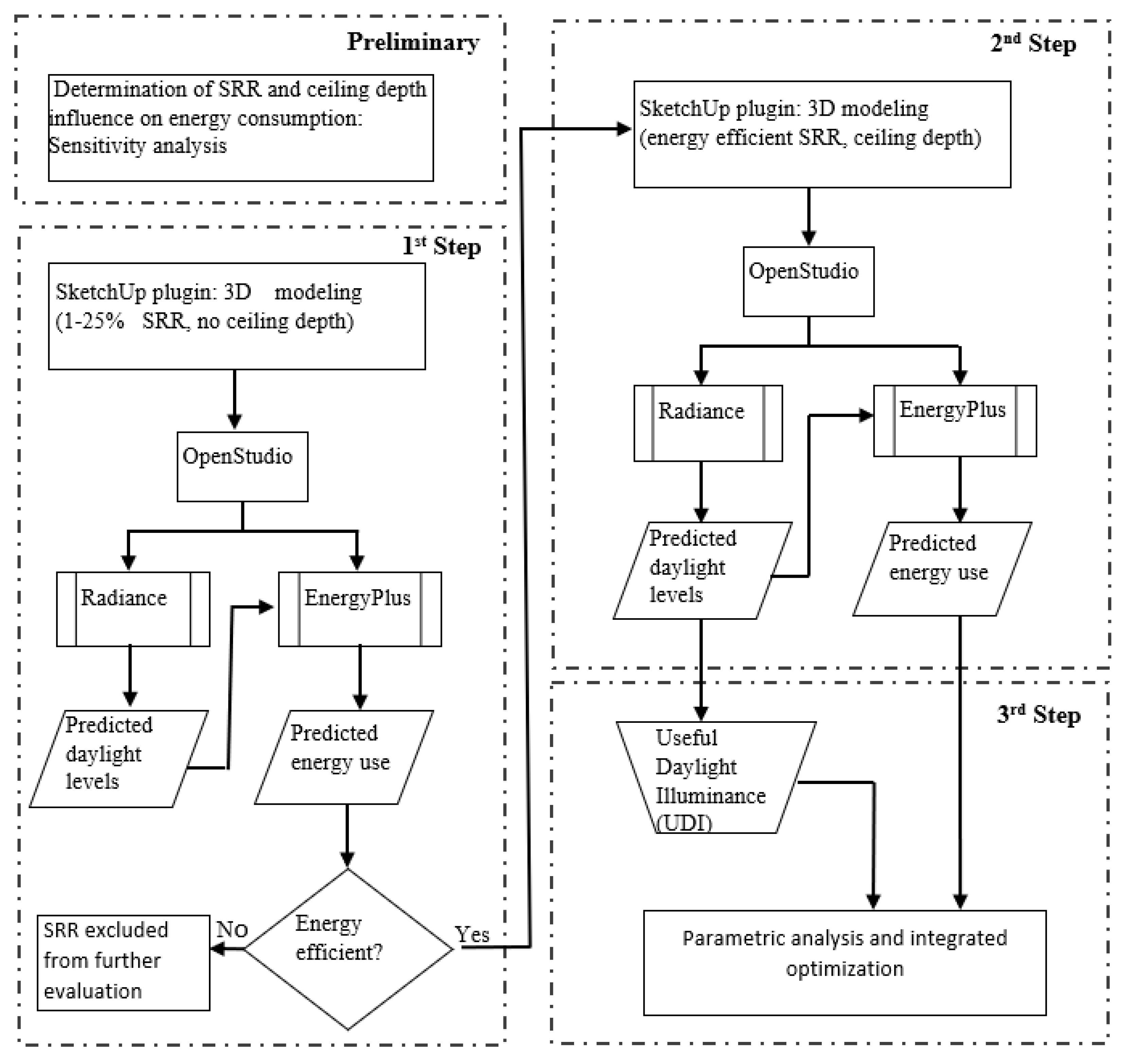
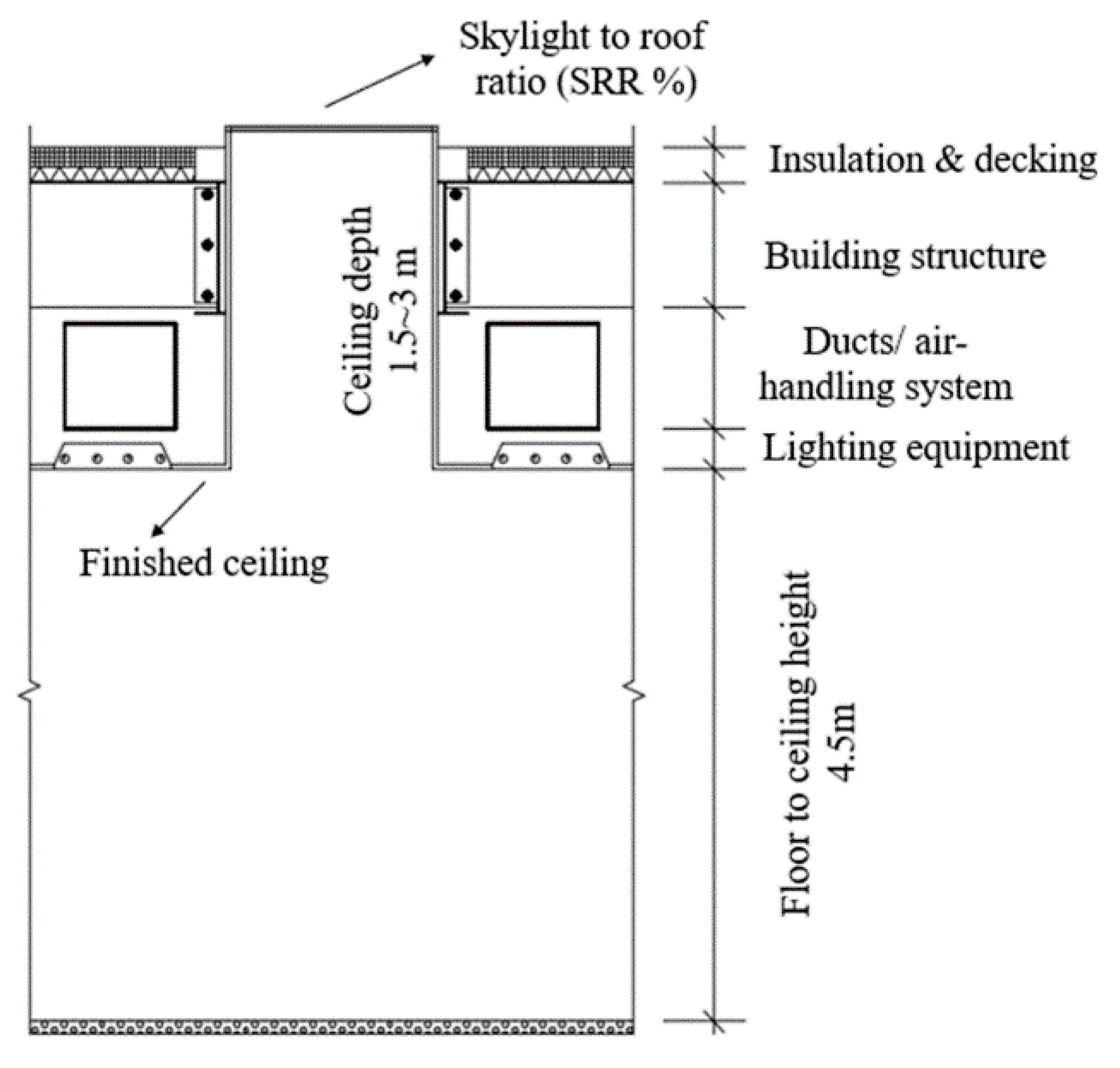
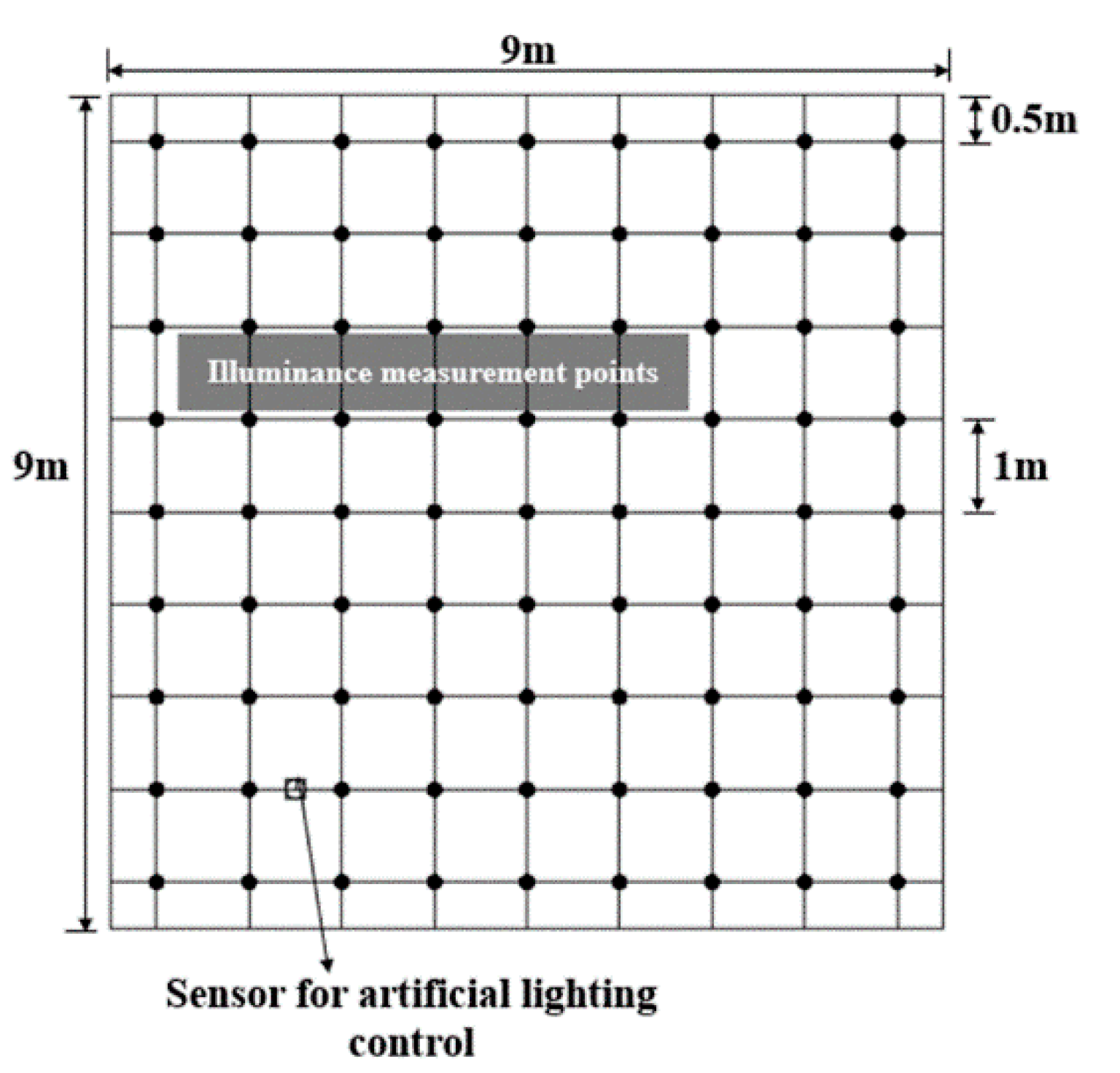
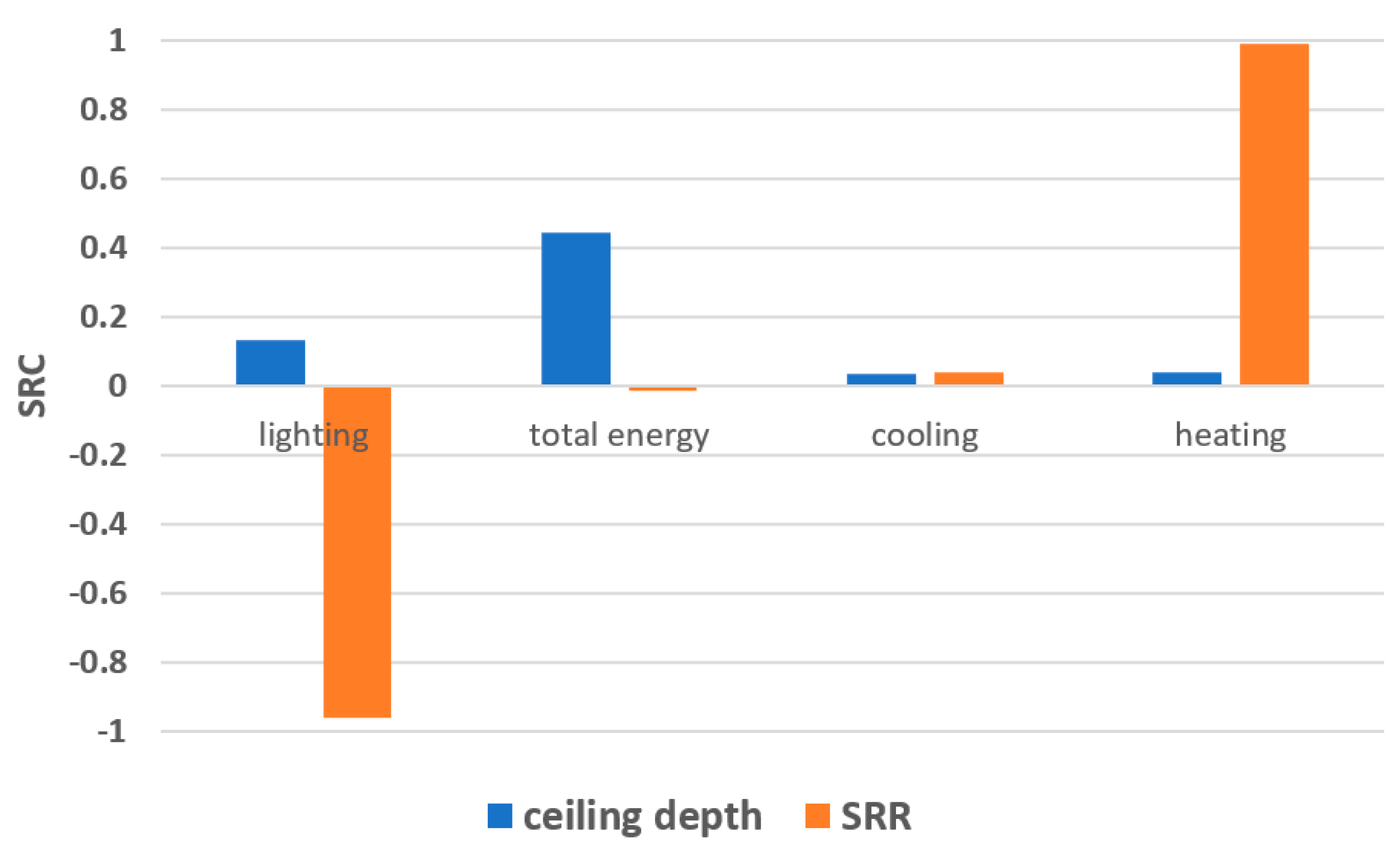

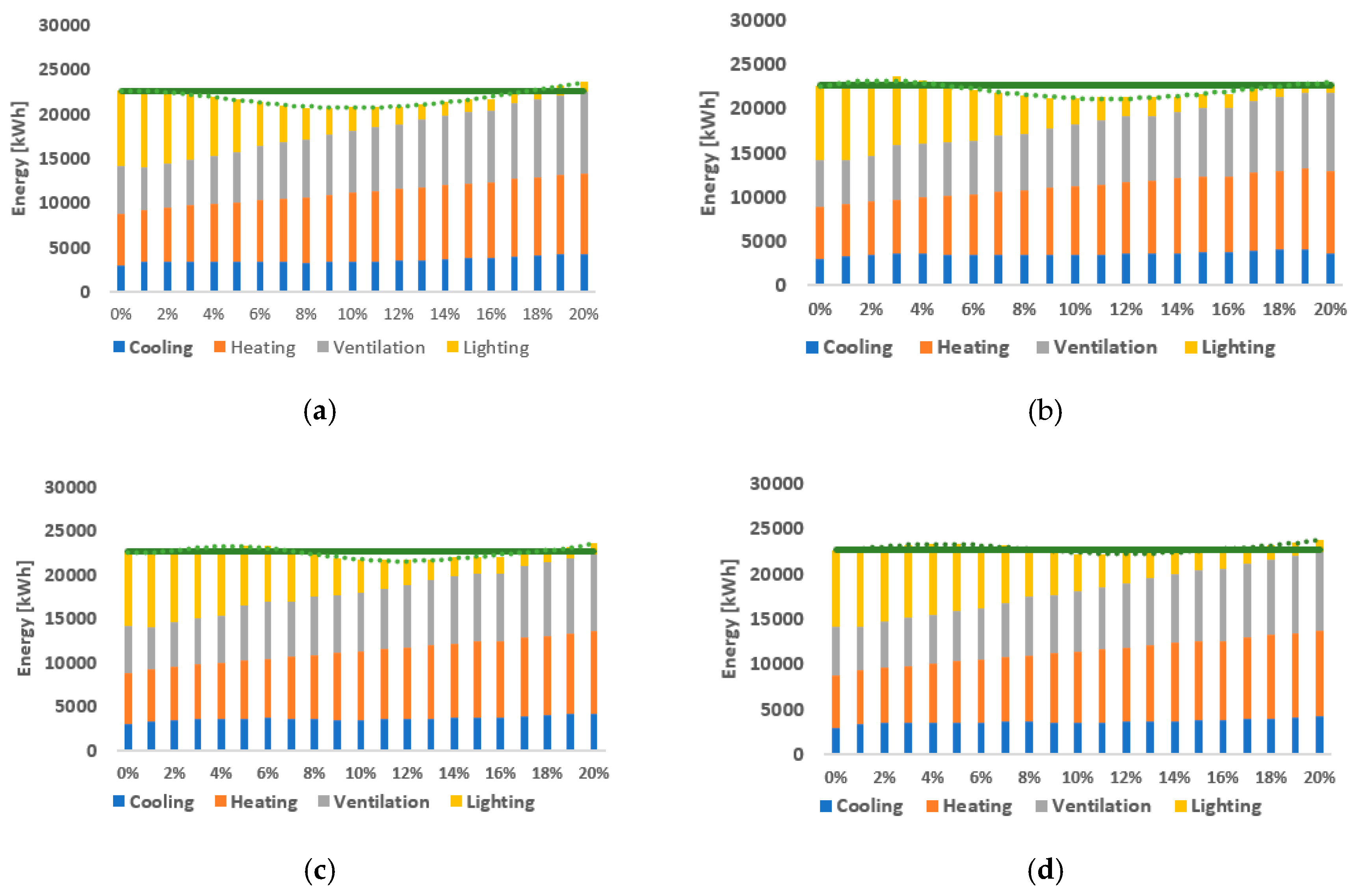
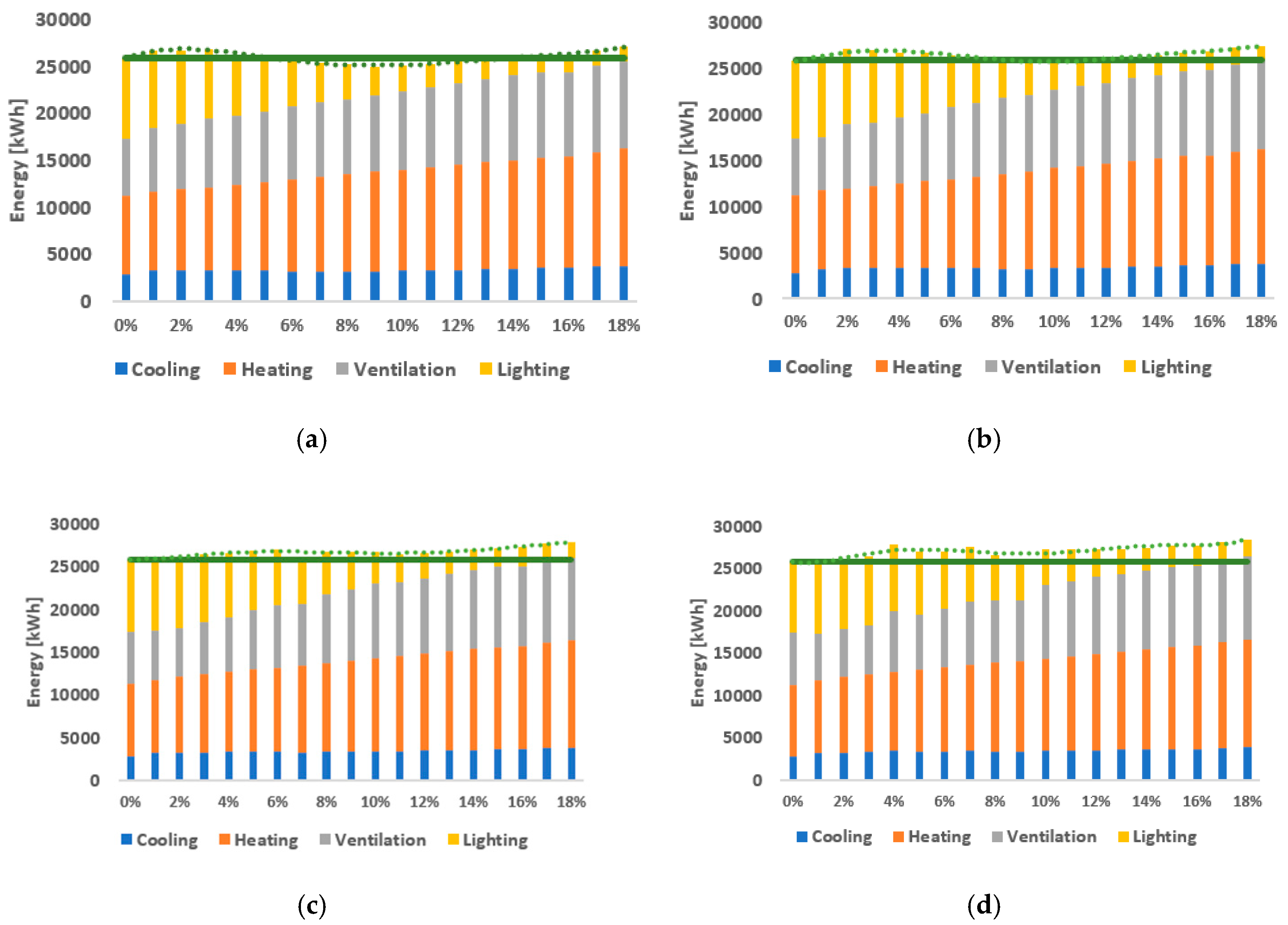
| Surface | Material | Reflectance | U-Value [W/m2K] | Visible Transmittance | Shading Coefficient |
|---|---|---|---|---|---|
| Floor | Brick + heavyweight concrete + insulation | 0.3 | 0.513 | - | - |
| Walls | Heavy concrete + insulation | 0.5 | 0.429 | - | - |
| Ceiling | Lightweight concrete + insulation | 0.7 | 0.192 | - | - |
| Glazing | Flat-styled CoolOptics | - | 1.98 | 0.67 | 0.37 |
| Category | Input | Values |
|---|---|---|
| Set points | Lighting Cooling Heating | 300 lux 24 °C 20 °C |
| Internal loads | Lighting density Occupancy People load | 11.34 W/m2 9.3 m2/person 117.2 W |
| COP | Cooling system Heating system | 3 0.8 |
| Infiltration | - | 2.19 m3/hr × m2 |
| Operation hours | 9am–5pm | - |
| Lighting control | Continuous dimming (3 steps) | - |
| SRR% | 1 | 2 | 3 | 4 | 5 | 6 | 7 | 8 | 9 | 10 | 11 | 12 | 13 | 14 | 15 | 16 | 17 | 18 | 19 | 20 |
|---|---|---|---|---|---|---|---|---|---|---|---|---|---|---|---|---|---|---|---|---|
| Ceiling Depth | ||||||||||||||||||||
| 0 m | P | P | Y | Y | Y | E | E | E | E | E | E | E | E | E | E | E | E | E | E | E |
| 1.5 m | P | P | P | P | Y | Y | Y | Y | E | E | E | E | E | E | E | E | E | E | E | E |
| 2 m | P | P | P | P | P | Y | Y | Y | Y | E | E | E | E | E | E | E | E | E | E | E |
| 2.5 m | P | P | P | P | P | Y | Y | Y | Y | Y | E | E | E | E | E | E | E | E | E | E |
| 3 m | P | P | P | P | P | P | P | Y | Y | Y | Y | E | E | E | E | E | E | E | E | E |
| SRR% | 1 | 2 | 3 | 4 | 5 | 6 | 7 | 8 | 9 | 10 | 11 | 12 | 13 | 14 | 15 | 16 | 17 | 18 | 19 | 20 |
|---|---|---|---|---|---|---|---|---|---|---|---|---|---|---|---|---|---|---|---|---|
| Ceiling Depth | ||||||||||||||||||||
| 0 m | P | P | Y | Y | Y | E | E | E | E | E | E | E | E | E | E | E | E | E | E | E |
| 1.5 m | P | P | P | P | Y | Y | Y | Y | E | E | E | E | E | E | E | E | E | E | E | E |
| 2 m | P | P | P | P | P | Y | Y | Y | Y | E | E | E | E | E | E | E | E | E | E | E |
| 2.5 m | P | P | P | P | P | P | Y | Y | Y | Y | E | E | E | E | E | E | E | E | E | E |
| 3 m | P | P | P | P | P | P | P | Y | Y | Y | Y | E | E | E | E | E | E | E | E | E |
© 2020 by the authors. Licensee MDPI, Basel, Switzerland. This article is an open access article distributed under the terms and conditions of the Creative Commons Attribution (CC BY) license (http://creativecommons.org/licenses/by/4.0/).
Share and Cite
Irakoze, A.; Lee, Y.-A.; Kim, K.H. An Evaluation of the Ceiling Depth’s Impact on Skylight Energy Performance Predictions Through a Building Simulation. Sustainability 2020, 12, 3117. https://doi.org/10.3390/su12083117
Irakoze A, Lee Y-A, Kim KH. An Evaluation of the Ceiling Depth’s Impact on Skylight Energy Performance Predictions Through a Building Simulation. Sustainability. 2020; 12(8):3117. https://doi.org/10.3390/su12083117
Chicago/Turabian StyleIrakoze, Amina, Young-A Lee, and Kee Han Kim. 2020. "An Evaluation of the Ceiling Depth’s Impact on Skylight Energy Performance Predictions Through a Building Simulation" Sustainability 12, no. 8: 3117. https://doi.org/10.3390/su12083117
APA StyleIrakoze, A., Lee, Y.-A., & Kim, K. H. (2020). An Evaluation of the Ceiling Depth’s Impact on Skylight Energy Performance Predictions Through a Building Simulation. Sustainability, 12(8), 3117. https://doi.org/10.3390/su12083117





